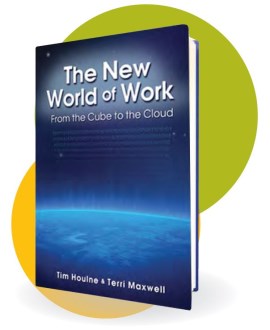by Terri Maxwell — In an opposing view to the decisions by Yahoo! and Best Buy to pull their virtual teams back to their officesi, my new book, “The New World of Work: From the Cube to the Cloud,” presents multitude of success stories that prove virtual work is not only possible, but necessary in order to maintain a competitive advantage.
The book describes the unstoppable forces that have combined to create this new reality:
- Work has been fractionalized. — Routine work has been broken into small tasks, and companies are hiring fewer full-time resources as they outsource projects.
- Careers have been virtualized. — With the advent of cloud technology, work has easily moved away from the confines of the cubicle. People can now work from any location and on their own schedule.
- Talent has become globalized. — The fractionalization of work and virtualization of careers have made talent truly exportable. Forget offshoring; crowdsourcing means that smart businesses can get talent anywhere, anytime.

My co-author, Tim Houlne, CEO, Working Solutions, and I believe Yahoo and Best Buy’s issues are due to a lack of appropriate management of their virtual teams.
First and foremost, you must identify, recruit and hire the right individual with the right skill set, who has the ability to work in a virtual environment. Team members must be self-motivated and thrive at managing their own time, as well as juggling multiple priorities.
Second, there has to be a solid virtual work strategy that encompasses these key factors:
- Manage the process and outcome, not the people.
- Utilize more peer-to-peer management to encourage collaboration.
- Invest in cloud technology and tools to manage projects.
- Understand virtual collaboration, both from a technology and a peer-to-peer communication standpoint, in order to get the best ideas.
- Physical presence does not improve creativity. Creative people engaged in the idea and committed to a solid outcome do.
New world of work leadership and management styles
Adapting to the new world of work and the empowered workforce will be a critical requirement for businesses to be competitive. If a company’s leaders fail to recognize, embrace and prepare their managers for it, they will be left behind.
Gone are the days of militaristic management styles dictated by control and intimidation. How do executives manage motivation in a virtual environment? Simply put, tie rewards directly to employees’ intrinsic motivations — their sense of empowerment and enjoyment.
Prepare your management team to embrace the empowered workforce by focusing more on the passions of the worker, rather than the management of work.
Time or money?
Yahoo Finance and Parade magazine teamed up for a job satisfaction/happiness survey conducted in the second quarter of 2012 to discover how Americans view their careers, jobs, work environments and futures. One of the key findings in the job happiness poll was that more than 60 percent of Americans would go back and re-write their careers. That means almost two-thirds of the people who make up today’s American workforce would hit the rewind button and start their careers over.

Why would the majority of working Americans want a re-do? This is an important question in the new world of work because it leads to another critical question: How can we increase job satisfaction? The answer is to move work to the cloud, fractionalize work and develop a compensation-based structure for performance and quality. Hard work and creativity should be rewarded based on individual contribution and as part of a team working toward a common goal or objective.
The most disturbing statistic from the study is that more than 35 percent said they would fi re their bosses. Is this because of the absence of managerial talent and leadership in today’s business? Perhaps. But it does suggest that embarking on a self-directed, conscious career choice of working as a “virtualprenuer” in a career that you are passionate about will lead to increased economic output and job satisfaction.
Mercer Research conducted a study in late 2011 which concluded that millennial-generation employees (those born after 1982) are 50 percent more likely to leave their jobs because they do not believe it is a “sound place to work.” So, that means half of the younger generation is looking for a better alternative.
The most compelling confirmation of the new world of work model is that two out of every three Americans would like to improve their workspaces. These findings corroborate the need for a next-generation workforce that chooses the task/work product, sets the compensation structure based on a perfect market system, and essentially works independently wherever they have access to the Internet. It also lays the groundwork for having world-class technology available for this workforce.
Bottom line: The four walls that once kept workers captive are gone. Over the last decade, technological and social changes have given rise to new, borderless business models.
How can facility management support the new world of work?
Create more welcoming workspaces. In a recent Business Weekii article about creating a workplace people will never want to leave, the advice is to listen to employees’ needs. Deliver diversity to allow many ways to work — in a team environment or solo, formal and informal conference rooms and open spaces. Support high-speed Internet access to empower virtual work strategies.
Just Google it
There is no better example of how to succeed in the new world of work than Google. The legend of how Larry Page and Sergey Brin invented an entire industry based on searching the Internet has become entrepreneurial lore.
Google processes more than one billion search requests each day and consistently boasts the highest number of visitors of any website in the world. What Google unknowingly created was technology-enabled access to information that continues to power the new work machine.
Those companies that pioneer new ways of empowering virtual workers will win, while professionals who find their passions and market them in the new world of work will ultimately rule. To take full advantage of the fractionalization of work, be prepared to try new ways of working and new ways of being.

As more and more companies adopt similar models and expand their labor reach globally, the cascading effect will become an accelerant for every organization to embrace the model or face irrelevance and extinction.
The empowered will challenge the status quo of yesterday’s organization and raise the bar on performance, creating frightening competition for organizations that fail to adapt.
The new auto assembly line
What happened when Henry Ford changed the way automobiles were manufactured? His ingenious business model, which included paying his help wages that allowed them to purchase these horseless carriages, created built-in customers to buy his automobiles. This turned Ford’s laborers into satisfied new customers, forever changing the way the world of commerce operates.
Technology is the key to creating the new assembly line in today’s workplace.
Virtual work platforms that remove all boundaries between the type of work offered and the type of work accepted are key to ensuring we don’t try to over-manage virtual talent and thereby kill the very spirit of it.
Think about what happens when companies compete for talent. Basically, in a no-boundaries world, the worker literally punches into work they find satisfying as long as the compensation is commensurate with the value of their output. The worker is empowered, and technology enables more freedom by ensuring the work is managed, rather than the person. This type of thinking, which is aided by technology rather than management, will increase the fractionalization of work, and thereby increase the pool of talent.
What does the future hold?
First, the world has no boundaries and everything is global. Anyone or any company with value to offer can market goods or services anywhere in the world with a click of a mouse or on a mobile device.
Individuals can contribute using collaboration tools. Today’s networks provide the horsepower to enable group work and crowdsourcing. Seamless communication across all channels, combined with the virtualization of most forward-thinking teams, creates an entirely new organizational model. In the new world of work, we like to think of this as the next organizational hierarchy, and it exhibits powerful contrasts: Technology is changing so rapidly that it is increasing the efficiency of all organizations, while empowering customers.
Customers are very different today than they were just a decade ago: They are more informed; they learn, live, work and play differently, aided by new technology.
British Prime Minister Winston Churchill famously said, “Those who fail to learn from history are doomed to repeat it.” Using history as our guide, we should be able to predict what will happen in the future. By applying the rapid changes of technological advances, we can start to “dream” about what the future of the world will look like in 10, 20 or 30 years.
As previously mentioned, facility management leaders can help create history by reimagining workspaces and supporting high-speed Internet access. You can make a difference in this new world of work.
“If you want something better, you have to be willing to do something different.” — Terri Maxwell
Resources
i “Best Buy follows Yahoo in banning flexible work”.
MSN Money. http://on-msn.com/10e4VNJ
ii “How to Create a Workplace People Never Want to Leave”.
Bloomberg Businessweek. http://buswk.co/10ZeDU3
Author biography

Terri Maxwell provides insights to transform businesses, people and industries. She is a leader known for simplifying formulas for success and igniting potential.
In a career spanning more than 20 years, Maxwell has put her talents to work for large and small companies and is a well-known consultant to businesses and entrepreneurs seeking to accelerate growth. She has built numerous successful companies and created an impressive business incubator, Succeed on Purpose Inc., in Irving, Texas, USA.